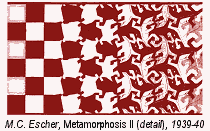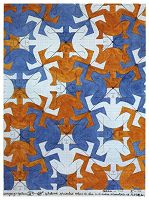 |
|||
|
|||
 |
|||
|
||
Essays on MathematicsOn this page we will post several of Ivan's essays on mathematics. 2004 UPDATES
In 2003, we posted Picture Puzzling, published in the January/February 1987 issue of The Sciences magazine (New York Academy of Sciences). In this essay, Ivan draws on the history of mathematics and anecdote to examine the limitations of the deductivist method; he advocates a greater reliance on pictures in mathematical reasoning and proof. To read the full article, download the Acrobat PDF file at the bottom of this page. Click on the thumbnails to view the larger images, all by the Dutch artist M.C.Escher, that accompanied the article. If there are other articles or essays by Ivan that you would like to see made available here, please contact Robert Rival. EPONYMY IN MATHEMATICAL NOMENCLATURE by MERV HENWOOD & IVAN RIVAL In any mathematics journal there may be found language such as that in the following abstract, which bears the title "A Boleslawskian Criterion for the Hughes-Williams Evaluation of non-Walquistness": Let S be the standard Smith class of normalized univalent Matcuzinski functions on the unit disc, and let B be the subclass of normalized WaIquist functions. We establish a simple criterion for the non-Walquistness of a Matcuzinski function. With this technique it is easy to exhibit, using standard Hughes-Williams methods, a class of non-Walquist polynomials. This answers the Kopfschmerzhaus-type problem, posed by R. J. W. ("Wally") Jones, concerning the smallest degree of a non-Walquist polynomial. Make no mistake: what we have here is not mere caricature. Although slightly embellished and utilizing imaginary surnames, it is nonetheless typical of much mathematical writing in its untrammelled use of the names of persons to identify ideas, techniques, theorems, and the like. This practice we shall call eponymy, from "eponym - [the name of] a person, real or legendary, from whom a theory, idea or object takes or is reputed to take its name." In non-mathematical, or non-technical, writing and speech many eponymous words have achieved through the slow accretion of popular acceptance over many years or centuries, a permanent and rightful place in the language. Thus it would be mere tomfoolery to quarrel with such words as sandwich, cardigan, sadism, shrapnel, or silhouette, all of which are taken from the names of persons and are thereby eponymous. Indeed, even in mathematics there are a few eponyms which are time-honoured and universally accepted; witness Boolean algebra, Cartesian coordinates, or Abelian group. Yet, while the place of such words in mathematical discourse is beyond question, what is not beyond question is the widespread practice, as in our introductory example, of recklessly coining and using new eponymous terms, without consideration either to possible alternatives or to likely consequences. [Read full article (PDF)] PICTURE PUZZLING by IVAN RIVAL MARJORIE RICE was an unlikely candidate for the role of mathematical innovator. The problem was tessellation, or tiling of the plane, which involves taking a single closed figure-a triangle, say, or a rectangle and fitting it together with copies of itself so that a plane is covered without any gaps or overlap. A region of this plane would look rather like a jigsaw puzzle whose pieces are all identical. M. C. Escher, the Dutch artist, who, like Rice, acquired mathematical insight without formal training, was a master at tessellation, as any number of his pictures show. But the tessellations in most of those pictures involved curves. Rice worked primarily with polygons, which consist only of straight lines. More specifically, she worked with convex polygons, in which the line joining any two points on the polygon lies entirely within the polygon itself or on one of its edges. (A five-pointed star, for example, does not qualify as a convex polygon.) By the time Rice took up tiling, its basic properties had been established. Obviously, any square can tile the plane, as many kitchen floors have demonstrated. Equilateral triangles are also a fairly clear-cut case. And there is one other regular polygon (a polygon whose angles, and sides, are equal) that can tile the plane: the hexagon. This fact was established by the ancient Greeks but had long before been exploited by honeybees in building their honeycombs. And what of irregular polygons? As it turns out, any triangle or quadrilateral, no matter how devoid of regularity, will tile the plane. Yet no convex polygon with more than six sides can do so, and the three classes of convex hexagons that can were uncovered by the end of the First World War. So the only real question left by the time Marjorie Rice happened on the scene was, Which convex pentagons tile the plane? [Read full article (PDF)] Illustrations that accompany the article: |
 |
|



